Abstract
Computer-aided classification serves as the basis of virtual cultural relic management and display. The majority of the existing cultural relic classification methods require labelling of the samples of the dataset; however, in practical applications, there is often a lack of category labels of samples or an uneven distribution of samples of different categories. To solve this problem, we propose a 3D cultural relic classification method based on a low dimensional descriptor and unsupervised learning. First, the scale-invariant heat kernel signature (Si-HKS) was computed. The heat kernel signature denotes the heat flow of any two vertices across a 3D shape and the heat diffusion propagation is governed by the heat equation. Secondly, the Bag-of-Words (BoW) mechanism was utilized to transform the Si-HKS descriptor into a low-dimensional feature tensor, named a SiHKS-BoW descriptor that is related to entropy. Finally, we applied an unsupervised learning algorithm, called MKDSIF-FCM, to conduct the classification task. A dataset consisting of 3D models from 41 Tang tri-color Hu terracotta Eures was utilized to validate the effectiveness of the proposed method. A series of experiments demonstrated that the SiHKS-BoW descriptor along with the MKDSIF-FCM algorithm showed the best classification accuracy, up to 99.41%, which is a solution for an actual case with the absence of category labels and an uneven distribution of different categories of data. The present work promotes the application of virtual reality in digital projects and enriches the content of digital archaeology.
1. Introduction
Cultural relics are the testimony of a country’s historical existence, the crystallization of human wisdom, which renders them highly precious for their historical, artistic, and scientific research value. China, an ancient country with a civilization over 5000 years old, has produced a variety of cultural relics with exquisite technology.
In the Tang dynasty, the developed economy and culture produced a prosperous pottery industry. Tri-color Hu terracotta figures, shown in Figure 1, a kind of glazed pottery, embody the unique aesthetic value of the Tang dynasty. This pottery takes magnificence as its modeling, splendor as its color, and warmth as its verve [1]. In many museums, art galleries, and in the hands of private collectors all over the world, there are numerous beautiful and colorful Tang tri-colored crafts that were excavated from tombs and kilns, ranging from 3D ceramic sculptures to various forms.

Figure 1.
Tang tri-color Hu terracotta sculptures.
The non-renewable nature of cultural relics makes them very precious. For enthusiasts or viewers, there are few opportunities to view cultural relics up close, because direct contact with cultural relics is likely to cause damage. If real-world cultural relics were to be digitized into 3D libraries, those interested would be able to query and view high-quality 3D models without direct contact with the real object. With the rapid development of 3D scanning and visualization technologies, heritage virtual management and display platforms have become an important means to store, classify, and retrieve cultural relics, and can also save time for the archaeologist. By obtaining a high-precision 3D model of an artistic relic, researchers can observe more finely the surface morphology and local features. This overcomes the disadvantages of the traditional methods of recording and storing cultural relics and may promote the efficiency of the information management of cultural relics [2].
Computer-aided classification and retrieval serve as the basis of virtual cultural relic management. In this stage, cultural relics are classified according to abundant information, such as the existing history and cultures. The anticipated outcome will be a part of the creation of a virtual museum dedicated to integrating cultural relic datasets coming from archaeological excavation activities. In this work, we aimed to develop an effective classification approach for 3D cultural relics that does not require sample labeling in advance. The contributions of this work are as follows:
Shape descriptors based on heat diffusion have been used in other applications of 3D shape retrieval [3,4], however, they have not been introduced and investigated for the purpose of classifying 3D cultural relics. To reduce the time complexity of calculations and improve the accuracy of feature extraction, we introduced the Bag-of-Words methodology to construct a low-dimensional descriptor called SiHKS-BoW that can accurately represent and describe the features of 3D cultural relics. We proposed an unsupervised learning algorithm to conduct the classification. Our proposed approach can be applied to cases in which the category labels of samples are absent or the distribution of the samples of different categories is unbalanced.
This paper is organized as follows. In Section 2, the feature extraction method of 3D shapes and some existing cases of cultural relic classification are first introduced. In Section 3, the data processing procedures are described. In Section 4, the details of the proposed approach are given. In Section 5, the experimental results and analyses are presented. Finally, our discussion and conclusion are provided in Section 6 and Section 7.
2. Related Work
2.1. 3D Shape Descriptor
In the pattern recognition and computer vision communities, 3D model classification and recognition play an important role in people’s understanding of the physical world. One of the challenges in these tasks is to evaluate the shape descriptor that can accurately capture the topological and geometric information on the surface of a shape [5]. The geometric essence of 3D shape can be succinctly represented by various descriptors extracted from their 3D formats, such as a voxel grid, point cloud, or polygon mesh. At present, 3D shape descriptors can be mainly divided into two categories. Shape descriptors can be considered as a local description of a point of 3D shape, and as a global description of the entire shape [6].
Although many shape descriptors have shown good performance in object recognition and shape matching, they have an underlying condition in that shapes are rigidly transformed, such as spin images [7], local patches [8], curvatures [9], and integral invariants [10]. There are many descriptors that are not sensitive to local geometric variance and are, thus, suitable for isometric transformations.
Shape descriptors based on heat diffusion [11,12,13,14], were proven to be very effective in capturing the features of 3D shapes. Heat kernel signature (HKS) [11] is a popular local descriptor with the advantage of invariance to isometric deformations and multi-scale properties. Scale-invariant heat kernel signature (Si-HKS) [3] was presented to solve the HKS scale problem with a series of transformations, such as the Logarithmic transformation and Fourier transform. The same research group then introduced the Shape Google approach [14] based on the Si-HKS.
A global shape descriptor, named a global point signature (GPS) [13], uses eigenvalues and eigenfunctions of the Laplace–Beltrami operator defined on a 3D surface to represent the entire shape. The GPS is invariant under isometric deformations of the 3D shape, yet does not use geodesic distances explicitly. The temperature distribution (TD) descriptor [15], is developed based on the heat mean signature (HMS) at a single scale to represent the entire shape. The L2 norm is used to compute the distance between two TD descriptors. Despite the descriptor showing its efficiency and effectiveness, describing the 3D shape of one single scale resulted in an incomplete description, while selecting an appropriate scale is often not simple.
The effective histogram-based descriptors, such as spin images [7], shape context [16] and color + shape descriptors [17] compressing geometric structures into bins, are more globally discriminate and less sensitive to local geometric variance. The signature of histograms of orientations (SHOT) [18] uses a unique local reference frame to calculate a descriptor along three axes. This descriptor outperforms spin images in object recognition and 3D multi-view reconstruction.
Using deep learning techniques to extract powerful features [19,20,21,22,23,24] has recently become a popular research area and can be effective for 3D shape classification, retrieval, and matching. Multiple popular representations of the 3D shape have led to the appearance of various deep learning feature extraction approaches. Volumetric Convolutional Neural Networks (CNNs) [21,25] are the pioneers of using 3D convolutional neural networks on voxelized shapes. Multiview Convolutional Neural Networks (CNNs) [26,27] attempt to map the 3D point clouds or shapes into a set of 2D images and, then, apply 2D Conv nets to extract features. Feature-based deep neural networks (DNNs) [28] convert the 3D shape into a vector, define the Eigen-shape and Fisher-shape descriptors as the output of deep neural network (DNN) for learning, and use a fully connected net to classify the shape. In the literature [29], a novel type of deep network named PointNet was designed. The PointNet directly consumes point clouds, and its applications range from object classification, to part segmentation and scene semantic parsing. Other effective and efficient deep network architectures [30,31] were proposed based on PointNet, which achieved promising performance on 3D shape classification tasks. In the literature [32], a deep learning approach to 3D shape classification using spectral graph wavelets and the bag-of-features paradigm was proposed, and a three-step feature description strategy was presented to capture both the local and global geometry of a 3D shape.
Unlike other traditional 3D shapes features, the features extracted by deep learning are inherent and hidden in the 3D shapes, which provide better overview ability. However, those methods often require a sufficiently large training set, and are not feasible when the training set is small.
2.2. 3D Cultural Heritage Classification
In general, the number of samples in a dataset has a large impact on the classifier. Lacking sufficient samples typically results in low efficiency or even overfitting. For cultural relics, the number of samples is relatively scarce. Therefore, some classifiers that require a large number of samples in the database, such as deep learning, are not suitable for cultural heritage classification. Currently, the classification of cultural heritage mostly uses statistical research methods and supervised machine learning methods.
Different from the classification of other objects, the classification of cultural objects has strong pertinence. It is difficult to compare the classification methods of cultural heritage with any one standard due to their unique characteristics. Computer-aided classification approaches applied to cultural heritage protection and virtual displays can become good examples.
Menze et al. [33] proposed an approach to classify multispectral aster imagery in an archaeological settlement survey in the Near East. The Random Forest method was chosen to classify the set of spectral features. The classifier was trained on the training data set and then applied to the test set. This method can be used in survey planning, the screening of large regions for nature conservation issues, or in landscape archaeology studies.
Ramil et al. [34] proposed a method based on artificial neural networks (ANN) and laser-induced breakdown spectroscopy (LIBS) to classify archaeological ceramics, including Terra Sigillata. Experimental results showed that the correct classification (higher than 95%) could be achieved objectively and systematically.
Philipp-Foliguet et al. [35] proposed a classification framework of ancient artwork 3D models, and the satisfactory results from this application domain were presented. They deal with database classification based on global and local shape descriptors. An SVM classifier coupled with an active learning strategy was used to retrieve categories of similar objects.
Hristov et al. [36] presented a classification method of archaeological artifacts that represents ceramic vessels depicted as 2D archaeological drawings. The classification was done by means of a standard k-nearest neighbor (k-NN) algorithm. Experimental results showed that their approach could achieve classification tasks related to the identification of whole vessels and their characteristic fragments.
Charalambous et al. [37] applied three machine learning methods for the compositional classification of 177 ceramic samples in Cyprus dated to the Early and Middle Bronze Age. The three well-known methods included a standard statistical learning method called k-nearest neighbor, a method based on decision trees, and a complex neural network based on learning vector quantization (LVQ).
Manferdini et al. [38] proposed a semantic classification method to assist the superintendence of archaeological sites or excavations in the digital management, classification, and visualization of finds inside an advanced repository.
Desai et al. [39] presented a classification method of archaeological monuments using Content-based Image Retrieval (CBIR) techniques. They applied visual features and the texture of 3D shapes to learn the art form and retrieved similar images from the reference collection.
Mangone et al. [40] confirmed the highly important role played by different complementary analytical techniques to arrive at a correct archaeological classification of the finds. X-ray diffraction analyses and scanning electron microscopy on ceramic bodies and coatings were performed to identify the provenance of lamps. Multivariate statistical analysis was used to classify various ceramic groups.
3. Preliminaries
Mesh and point cloud are two mainstream formats of 3D shape representation. The raw data of cultural relics, obtained using an Artec3D Scanner, are often very large, and there also exists noise data. Therefore, a series of preprocessing of the original data is needed to meet the requirements of the subsequent feature extraction algorithm.
3.1. Original Data Pretreatment
In the process of scanning, the occlusion on object surfaces results in the scanner being unable to collect data in any direction. To avoid incomplete scans, the object must be scanned with multiple angles. The complete 3D model is then obtained by aligning and registering the scanned data onto multiple angles. The roughness of object surfaces may cause a phenomenon of reflection or diffuse reflections when the laser irradiates. The scanners inevitably make errors because of jitter, preheating, and other issues. All these factors result in the formation of holes in the scanning process. The sight interference and occlusion of other objects and many other factors may generate noise points and speckles in the scanned model. Thus, data pretreatment was necessary to correct defects, such as holes, noise points, and speckles. The specific preprocessing steps using Geomagic software are listed below:
- (1)
- Align and register the raw scanned data.
- (2)
- Delete isolated points outside of the object in vitro.
- (3)
- Eliminate noise point and filter speckles.
- (4)
- Patch the holes in the 3D model surfaces.
3.2. 3D Mesh Simplification
In computer graphics, every mesh model is represented as a collection of vertices, edges, and faces. To enhance the performance of applications working with polygonal mesh models, the collection of faces is often reduced to a small subset that holds its basic topology. Table A1 lists the number of vertices and triangle faces of 41 3D models in our dataset before and after simplification.
Figure 2 is a case in which the triangle faces of model No.86 were reduced from 943,844 to 10,000. As the 3D shape in our dataset is watertight, the number of vertices is reduced, the topology information of the shape is still well preserved and, thus, the ability of feature representation of the 3D model is not weakened after the mesh simplification.
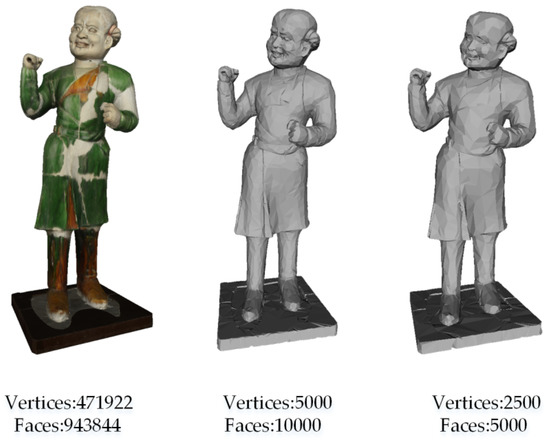
Figure 2.
The 3D shape (left) and its simplified versions (middle and right).
4. The Proposed Method
Our study aimed to develop an effective approach to address cultural relic classification problems. There were three key problems needing to be solved (a) how to obtain a powerful descriptor that well expresses the internal structure of a 3D shape; (b) how to construct a compact low-dimensional feature and make the learning efficient; and (c) how to choose the optimal classifier for our classification task.
Figure 3 illustrates each key step of our approach in detail. First, every model was converted to a 3D mesh and simplified. Secondly, the heat kernel value of each point in the corresponding 3D mesh was calculated, and the Si-HKS descriptor was produced. Thirdly, the Bag-of-Words (BoW) methodology was employed to transform the Si-HKS descriptor into a low-dimensional SiHKS-BoW descriptor. Finally, an unsupervised learning algorithm was used to complete the classification task in the 3D cultural relic dataset.
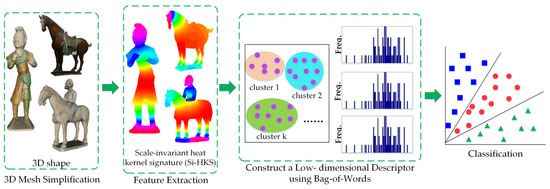
Figure 3.
Flow chart of the proposed method.
Why did we choose the Si-HKS descriptor to represent the shape features of 3D cultural relics? First, the heat kernel was linked to the curvature of the 3D shape surface. Points in the flat regions with low curvature tend to dissipate heat while points in the corners with high curvature tend to attract heat. Thus, the heat kernel can characterize the intrinsic geometry structure of a 3D shape well. Second, Si-HKS’s ability to handle data under several distortion scenarios made it ideal for our cultural relic classification task, because there are isometric deformation and scale changes in our 3D models. Finally, the extraction time of heat kernel features is relatively fast, which can meet real-time needs.
Why did we introduce the Bag-of-Words mechanism to conduct a low-dimensional descriptor? There were two main reasons: one was the need to find densities in the feature space, another was the need to standardize the size of descriptor. The heat kernel feature of each 3D model is an N ∗ T dimensional tensor, where N represents the number of vertices of the 3D shape and T represents the time scale or frequency. 3D models typically have tens of thousands of points; thus, the dimensions of the heat kernel descriptor are very high, and the cost of similarity calculation is very high. The Bag-of-words mechanism is capable of feature dimension reduction, which is a common task in the pattern recognition domain.
The numbers of vertices in each 3D model in our experiments were different after the mesh simplification, which led to inconsistent dimensions in the Si-HKS descriptor. Therefore, we needed to further transform the features into a standard tensor.
Why did we choose the MKDSIF-FCM algorithm as a classifier? Although many supervised learning classifiers fully demonstrated high efficiency in the classification task, a notable problem is that it is not applicable in cases without category labels of the samples. Another situation is that, when the distribution of the samples of different categories is not balanced, the effect of using supervised learning for classification may not be better than unsupervised learning. In a previous study [41], we proposed an improved algorithm of FCM (fuzzy c-means), named MDSIF-FCM. Our experimental results on the public dataset demonstrated its effectiveness, and we obtained good classification accuracy when we applied it to a skull dataset. This is an unsupervised learning method, which was very suitable for the classification task in our current work.
4.1. Heat Kernel Feature
Sun et al. [11] proposed a novel point signature called the heat kernel signature (HKS), which is based on the properties of the heat diffusion process on a 3D shape and obtained by restricting the heat kernel to the temporal domain. The HKS is invariant under isometric deformations or perturbations of the objects and demonstrated sufficiently good performance in object recognition and retrieval. In this section, we start with the basics of heat kernel theory.
4.1.1. Heat Kernel Basics
A 3D shape can be approximately viewed as a Riemannian manifold, possibly without boundaries. The heat kernel denotes the heat flow of any two vertices across a Riemannian manifold M. The heat diffusion propagation on M is governed by the heat equation as follows:
where and t denote a Laplace–Beltrami operator of M and the diffusion time, respectively. The solution with initial condition describes the amount of heat on the manifold at point x in time t. satisfies the Dirichlet boundary condition for all and all t.
Given an initial heat distribution , denotes the heat distribution at all times t, and . Here, is called the heat operator. It is easy to verify that and satisfy the relation and share the same eigenfunction. If λ is an eigenvalue of , then is an eigenvalue of .
Heat kernel can be thought of as the amount of heat that is transferred from point x to point y in time t given a unit heat source at x. In other words, , where is the Dirac delta function at for any , and .
The heat kernel on any compact manifold M has the following eigen decomposition:
where and are the i-th eigenvalue and corresponding eigenfunction of the Laplace–Beltrami operator, respectively.
4.1.2. Heat Kernel Signatures (HKS)
The heat kernel is restricted to a subset of , under mild assumptions, maintains all the information of . The heat kernel signature (HKS) describes the heat at a point x on the Riemannian manifold M over the temporal domain t. is defined as a function:
The value of the HKS is dominated by t and has multi-scale characteristics in the temporal domain. The time parameter t is discretely expressed as t1, t2, …, tn. The heat kernel signature at point x can be regarded as a discrete sequence:
4.1.3. Scale-Invariant Heat Kernel Signatures (Si-HKS)
The HKS is a robust local signature with many good properties, but it is very sensitive to the scale. Given a shape X and its scaled version , their eigenvalues and eigenfunctions will satisfy , and, therefore, has the equation as follows:
Bronstein [3] applied a series of transformations to h for achieving scale invariance. First, the heat kernel signature at point x is sampled logarithmically in time, w.r.t. to form the discrete function:
Scaling the 3D shape by β will result in amplitude-scaling by and a time shift by :
Second, the multiplicative constant is removed by taking the logarithm of h, and then the discrete derivative to :
Finally, the discrete-time Fourier transform of turns this time shift into a complex phase:
where H and are the Fourier transform of h and , respectively, and . The phase is, in turn, eliminated by taking the Fourier transform modulus (FTM):
The scale-invariant signature at each point x is constructed, denoted as the scale-invariant heat kernel signature (Si-HKS).
From Figure 4a, the amount of heat remaining on the surfaces of the original model and the scaled model are completely different. This proves that the heat kernel signature is very sensitive to scale changes of the 3D model. Figure 4b shows that the heat distributions of two different versions are virtually identical. Compared with HKS, the Si-HKS algorithm is not sensitive to scale changes.
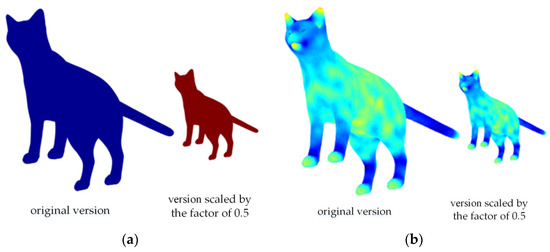
Figure 4.
Heat kernel feature computed at a corresponding point on a cat model and its version scaled by a factor of 0.5: (a) The heat kernel signatures; (b) the scale-invariant heat kernel signatures.
4.2. Construct a Low-Dimensional Descriptor
The Bag-of-Words (BoW) mechanism [42] and its variants achieve impressive performance and have been applied to perform classification and retrieval tasks. In image analysis, an image is described as a collection of local features from a given vocabulary, resulting in a representation referred to as a bag of features [43,44]. In shape analysis, such methods have been introduced to describe visual words of 3D shape [8,14,45,46,47]. In the literature [48], a hybrid feature descriptor was encoded using codebook for automatic recognition of human interaction. In this work, the Bag-of-Words methodology was applied to construct the SiHKS-BoW descriptor. The details of this mechanism are presented in the following paragraphs.
4.2.1. Evaluating the Si-HKS
The Bag-of-Words model represents a 3D shape as a collection of visual words. Figure 5 shows a scheme for evaluating the scale-invariant HKS descriptor. First, the 3D model is simplified with approximately 5000 vertices. Secondly, the Laplace–Beltrami operator of the vertex is calculated and then decomposed to obtain the corresponding eigenvalues and eigenvectors. Then, the first N eigenvalues and their corresponding eigenvectors are selected and substituted into the heat kernel equation to obtain the HKS descriptor. Finally, discrete-time Fourier-transform and phase-amplitude are used to eliminate the scaling instability of the heat kernel signature; thus, the Si-HKS descriptor is obtained.
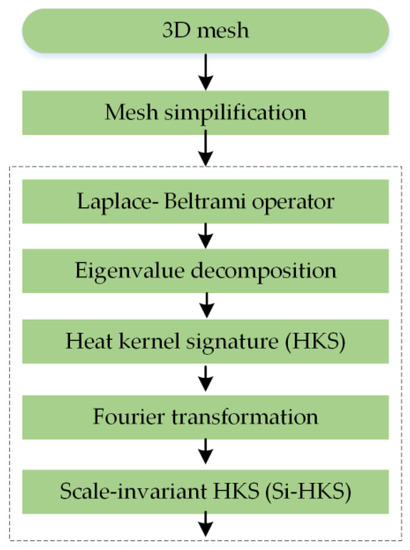
Figure 5.
A work-flow for evaluating the Si-HKS.
4.2.2. Visual Codebook Generation
We used the Si-HKS values of densely distributed vertices as elements to construct “geometric words”. To obtain k patterns of all vertices and create the vocabularies, we applied the standard k-means clustering algorithm that was suggested and used in the literature for similar tasks. Then, similar values of Si-HKS were clustered together and assigned the same visual words. As the number of the clusters (K) is much smaller than the number of the vertices (N), the time cost of the similarity calculation was greatly decreased.
4.2.3. Feature Quantization and Score Calculation
Once we have the codebook, every Si-HKS of a vertex takes a word assigned to its cluster centroid. Si-HKS is represented as a collection of visual “words”, and each 3D shape is converted to a bag of words. Counting the frequency of the visual words in the codebook occurrence, a global feature called “SiHKS-BoW” was constructed.
4.3. Classifier
FCM (fuzzy c-means) [49] is one of the best-known clustering algorithms for data mining. Clustering is a process for grouping a set of data into classes so that the data within a cluster have high similarity but are very dissimilar if the data are in different clusters. For traditional FCM, the performance has been limited to the Euclidean distance. We previously proposed an improved FCM algorithm named MKDSIF-FCM [41]. Our experimental results verified the effectiveness and generality of the MKDSIF-FCM algorithm on a publicly available dataset and 3D skull dataset.
The MKDSIF-FCM algorithm puts forward the concept of a distance weighting coefficient with an influence factor (IF) and incorporates the advantage of multiple kernel learning.
Assume X = {x1, x2, …, xn} is a set of m-dimensional samples, where xj = {xj1, xj2, …, xjm} represents the jth sample for j = 1, 2, …, n. The ith cluster is expected to have the center vector vi = {vi1, vi2, …, vim} (1 ≤ i ≤ c), where an integer c (2 ≤ c ≤ n) is the number of clusters.
U∈Rc×n is a c × n matrix of fuzzy partition for given xk = {xk1, xk2, …, xkm} (k = 1, 2, …, n), where uik∈U is a membership function value from xk to vi, and uik is subject to the following conditions:
The iterative optimization is used to approximate the minima of an objective function JS. In minimizing JS, the basic steps are performed in the following procedures:
--Step 1. Given a value of parameters c and let s = 2.
--Step 2. The matrix U of fuzzy partition is initialized by generating c×n random numbers in the interval [0, 1].
--Step 3. For t = 0, 1, 2, …, FCM algorithm is used to calculate vi (i = 1, 2, …, c) by using U as follows:
--Step 4. The wik is calculated according to (14) and (15),
--Step 5. The objective function JS is computed by using (16),
--Step 6. The fuzzy partition matrix U and the cluster centers V are updated by minimizing objective function JS. The of uik and vi is calculated according to (17) and (18), respectively.
-- Step 7. The process is stopped if the following condition holds:
where it converges or the difference between two adjacent computed values of objective functions JS is less than the given threshold ε.
Otherwise, go to step 4.
5. Experiment Results and Analysis
5.1. Experiment Environment and Testing Dataset
The proposed approach was implemented on an Intel® Core™ i9-9900k CPU @ 3.60 GHz desktop computer with 64 GB RAM and 2 GeForce RTX 2070 GPU running MS Windows 10. The experimental environment was based on MATLAB R2019b, and all 3D models were obtained by an Artec3D Scanner. To verify the effectiveness and show the potential application of our approach, we conducted experiments on the Tang tri-color Hu dataset, which contained 41 samples. The dataset consists of three classes: people, animals, and others. In our experiments, the raw data was simplified as a model with about 5000 vertices and 10,000 faces, as shown in Table A1. In our experimental setup, we closely followed the original works theoretically, and we selected the optimal parameters to yield the best performance on our dataset. For the classification rate and running time presented in this work, the experiments were repeated 50 times, and the average results were obtained for comparison.
5.2. Evaluation of Si-HKS Descriptors
In our experiments, 100 eigenvalues and eigenvectors were computed and the heat kernel value at vertex x was computed in the logarithmic scale over the time (t = ατ).
5.2.1. Parameter Setting
To construct the HKS descriptor, we used a logarithmic scale-space with base α = 2 and τ ranging from 1 to 30 with increments of 0.5. The heat kernel value of each vertex was a (2 × τ − 1) × 1 dimensional tensor, and a (2 × τ − 1) × n dimensional shape descriptor was obtained by combining the heat kernel values of all the vertices from the 3D models, where n and τ are the number of vertices and the time scale.
To construct the Si-HKS descriptor, the amplitude of the Fourier-transform (FT) was used to achieve scale invariance. Most of the signal information is usually contained in the low-frequency components of the Fourier-transform. In our experiments, the Si-HKS descriptor was sampled at a small number of low frequencies. We set the frequency f ranging from 1 to 40 with increments of 1, and, thus, the first 40 discrete lowest frequencies were used to construct the Si-HKS descriptor.
5.2.2. Performance Evaluation
For the chosen 3D cultural relic models, their heat kernel values of all vertices were calculated and visualized. As sketched in Figure 6, the resulting heat kernel distributions were colored according to the values of Kt (x, x) at time scale τ = 30, where different colors represent different heat kernel values.
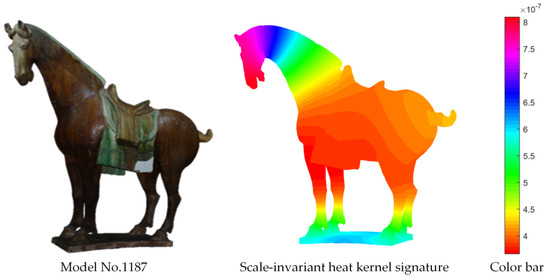
Figure 6.
A 3D shape and its heat kernel signature. Left, the 3D Tang tri-color model. Middle, the visual effect of the heat kernel descriptor. Right, the map between color and the value of the heat kernel.
We randomly selected f = 1, f = 3, f = 8, and f = 15 from 40 frequencies and mapped the Si-HKS onto 3D cultural relic models (No.4, No.57, No.71, and No.80). As shown in Figure 7, we can see the 3D Tang tri-color models belonging to the same class tended to have similar heat distributions and contained similar visual information. Thus, using Si-HKS descriptors, we can evaluate the similarity between 3D shapes.
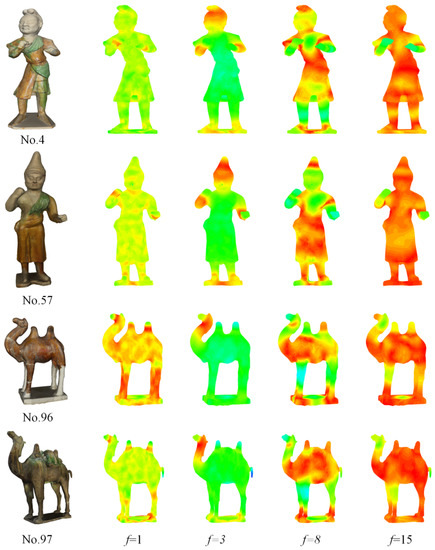
Figure 7.
Visual representation of Si-HKS at different frequencies.
In classification and retrieval tasks, deformations on the body due to movement make recognizing articulated shapes, such as humans or animals, very challenging. The Si-HKS is invariant to isometric deformations. Figure 8 shows the visual representations of Si-HKS for two camels with different poses. Clearly, the heat distributions of models No.96 and No.97 are very similar at different frequencies f.

Figure 8.
Visual representation of Si-HKS for model No.96 and No.97.
5.3. Evaluation of Mesh Simplification
When scanning the cultural relics by 3D scanner, the obtained 3D data is typically large, and thus leads to high computational complexity and a long computational time. It is often necessary to simplify the original data to an appropriate size.
As shown in Table 1, when the number of vertices of the model are changed from 670,070 to 5050, the time taken to compute the Si-HKS descriptor is reduced from 2 minutes to less than 1 second, which should be reasonable. It is therefore necessary to simplify the model before feature extraction.

Table 1.
Comparison of feature extraction times for model No.26 and its simplified versions
Figure 9 shows the visual representations of Si-HKS for model No.26 and its simplified versions. When the numbers of vertices were reduced from 670,070 to 5050, the heat distribution of Si-HKS on the surface of the simplified model was almost unchanged at different frequencies f compared with the original model. This indicates that the characteristic description ability of the Si-HKS will not be weakened if the model is simplified to an appropriate size.
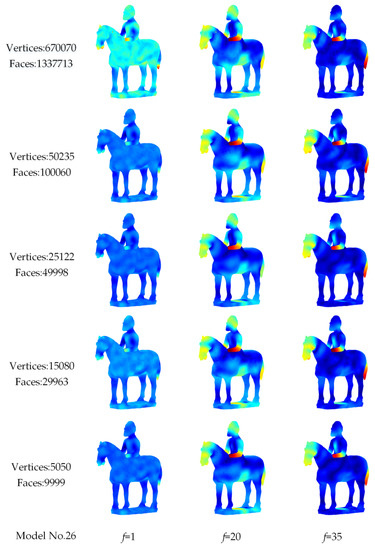
Figure 9.
Visual representation of Si-HKS for model No.26 and its simplified versions.
5.4. Evluation of SiHKS-BoW Descriptor
During the construction of the SiHKS-BoW descriptor, the selection of the size of the codebook (K) is very important and can impact the final classification accuracy.
To obtain the optimal codebook size (K), the SiHKS-BoW was evaluated using the most commonly used classifier, SVM. The evaluation protocol splits the 41 datasets into 26 training samples and 15 test samples. We can see from Figure 10 that a too large or too small value of K may cause the descriptors to be less discriminating and the accuracy to be decreased. In our experiments, the selection of K was mainly by heuristics. The best result up to 98.13% for the SiHKS-BoW descriptor was obtained when the value of K was 20.
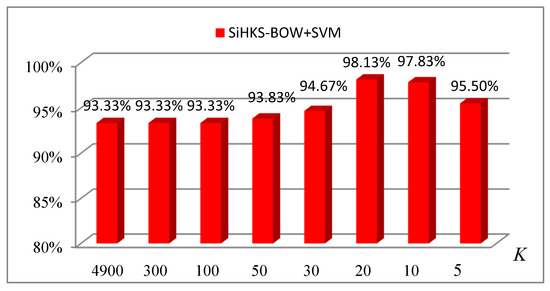
Figure 10.
Illustration of the classification accuracy of different codebook sizes (K) in constructing the SiHKS-BOW descriptor.
In Figure 11, when the value of K was 300, we obtained the highest classification accuracy of 86.33% using the HKS-BoW descriptor. Clearly, the classification accuracy obtained with SiHKS-BoW was 12% higher than that with HKS-BoW. This also implies that the models in our dataset may not be consistent in scale. The scale invariance of the Si-HKS descriptor makes it outstanding in our classification task, which is why we chose the Si-HKS descriptor in our work.
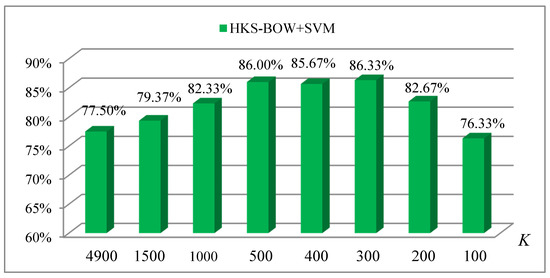
Figure 11.
Illustration of the classification accuracy of different codebook sizes (K) in constructing the HKS-BOW descriptor.
5.5. Classifiers Selection
To verify the classification performance of MKDSIF-FCM on the cultural relic dataset, we compared the results using several popular classification methods, including decision tree, BP neural network, SVM, H-ELM [50], and MKDSIF-FCM.
Here, we first focused on a detailed analysis of the parameters of the MKDSIF-FCM algorithm. There are six parameters (s, p1, p2, σ1, σ2, and β) that must be set in the MKDSIF-FCM algorithm, where s represents the fuzziness index, p1 and p2 represent the probability, σ1 and σ2 represent the parameters of the Gaussian kernel function, and β represents the influence factor (IF).
The parameters in MKDSIF-FCM were set as s = 2, β = −0.2, p1 = 0.7, p2 = 0.3, σ1 = 30, and σ2 = 120.
The experimental results of Figure 12 suggest that MKDSIF-FCM produced fairly high accuracy at 99.41%, and this was superior to the other classifiers we tested. Both H-ELM and SVM did a good job with a high accuracy over 95%. The classification accuracies of the BP neural network and decision tree were no more than 90%.
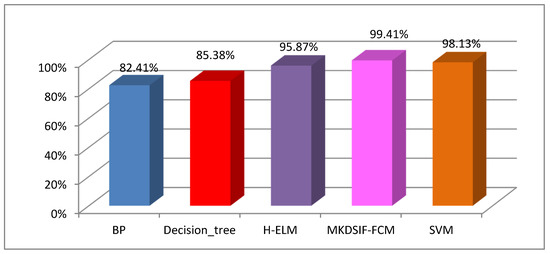
Figure 12.
Comparative analysis of the classification accuracies for several popular classifiers on the cultural relic dataset.
Table 2 shows that the longest classification time occurring using BP neural networks, and the shortest was with SVM. As for H-ELM and MKDSIF-FCM, the running time was at a similar level. The decision tree’s running time was slightly longer than H-ELM’s.

Table 2.
Comparative analysis of the time cost for several popular classifiers.
As can be seen from the above experimental results, both SVM and MKDSIF-FCM showed excellent classification performance in terms of the classification accuracy and running time. SVM is one of the most popular classifiers that succeeds in object recognition and classification. However, it is a supervised learning method, which requires labelled samples in advance.
5.6. Performance Analysis of the Proposed Approach
In general, there is always at least one optimal K that can obtain the highest accuracy when using a Bag-of-Words representation. As shown in Figure 13, when the codebook size (K) is 300, the best average accuracy was obtained using the MKDSIF-FCM algorithm, up to 99.41%.

Figure 13.
The influence of the codebook size (K) on the classification accuracy.
5.6.1. Time Cost
The time cost of the proposed approach in each running stage is listed in Table 3. In three stages, the time needed to calculate the Si-HKS descriptor was the longest, up to 46 s. This also shows the necessity of simplifying the model before feature extraction. The time it takes to classify occupies a very small period of time in the whole process of the classification task. The time to construct the SiHKS-BoW descriptor is related to the value of parameter K; the greater the value of K, the longer the time. When the value of K was reduced from 4900 to 20, and the time cost of constructing of SiHKS-BoW was reduced by about 200 s, this had a large impact on the overall running time in the classification task.

Table 3.
Comparative analysis of the time cost of the proposed approach.
In our classification task, when the value of K was 300, we obtained the best classification with 99.41% and the total running time of 60.8793 s that meets the requirements of classification tasks in many real-time scenarios.
5.6.2. Stability Analysis
When conducting the classification task, we hoped that the results could be reproduced. It is very important that the method is stable. As shown in the line chart in Figure 14, the stability of the proposed method in detail was further analyzed. The experimental procedure was repeated 50 times, and the difference between maximum and minimum accuracy was around 7%. In 50 experiments, the classification accuracies reached 100% over 41 times. The minimum accuracy was 92.68%. The combination of Si-HKS-BoW + MKDSIF-FCM presented stable performance on our cultural heritage dataset.
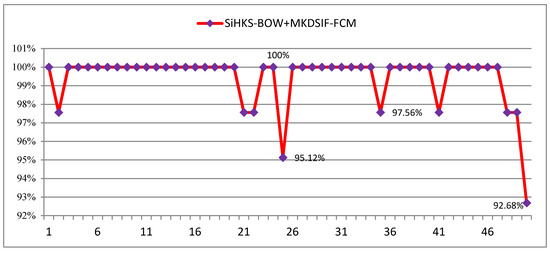
Figure 14.
Stability analysis for the proposed approach.
6. Discussion
The experimental results demonstrated that the Si-HKS descriptor could achieve high performance on our dataset, and its ability to handle data under isometric deformation and scale change make it ideal for our cultural relic classification task.
Extracting the Si-HKS descriptor from a small simplified model is beneficial in improving the computational efficiency. As shown in Figure 9 and Table 1, we can see the time needed to compute the Si-HKS descriptor is greatly reduced after the model simplification, but the discriminative power of descriptors did not change drastically.
Although we simplified the model before feature extraction, the dimensions of the extracted Si-HKS features are still as high as around 5000. A high dimension not only brings a high computational cost, but is also harmful to the classification accuracy. Therefore, it is necessary to further find densities in the feature space and to construct low-dimensional features with good descriptive ability. The size K of the codebook denotes the number of the clustering center. In general, the value of K is much smaller than the number of vertices, and the value of the Si-HKS of each vertex is allocated to each cluster center to achieve the purpose of feature dimension reduction.
There is also a very important objective reason why we constructed the SiHKS-BoW descriptor using the Bag-of-Words methodology. The existing model simplification methods cannot make the number of vertices of the simplified model be the same, which leads to inconsistency of the dimension of the HKS of each model, and also provides trouble for the classification of the later. Therefore, we needed to transform the Si-HKS into a tensor of a uniform size to complete the classification task.
The experimental results fully indicate that compared with the Si-HKS descriptor, a low-dimensional SiHKS-BoW has a considerable benefit to the classification accuracy and the over running time.
We proposed a stable and efficient unsupervised learning algorithm that we previously abbreviated as MKDSIF-FCM [44] to complete the classification task for a cultural relic dataset. We compared it with several supervised classification methods, including a decision tree, BP neural networks, H-ELM, and SVM. The experimental results showed that MKDSIF-FCM obtained best classification performance for the classification accuracy and time consumption at 99.41% and 0.0024 s, respectively. As a result of the fairly high accuracy, small time cost, and the advantage of unsupervised learning, we have reason to believe that MKDSIF-FCM is the most suitable classifier for cultural relic data in which category labels of the samples are absent or when the sample categories are unbalanced. Our experimental results also indicated that the SiHKS-BoW descriptors we constructed were very accurate and effective in our classification task.
In our experiments, the acquisition of the optimal K was mainly by heuristics. We experimented with all possible values of K rather than choosing a specific value because different K can be useful or harmful depending on the features extracted and the classifier used. How to determine the optimal K automatically with an effective method will be a research topic to investigate in the future.
In the MKDSIF-FCM algorithm, the determination of a set of optimal parameters also depended on heuristics. We will perform more extensive studies on this in the near future and attempt to develop other unsupervised classification methods.
7. Conclusions
In this paper, we proposed an efficient classification approach for the Tang tri-color Hu terracotta figures, which was composed of four main phases: (i) data gathering and preprocessing, (ii) estimation of the Si-HKS descriptor, (iii) construction of a new low-dimensional feature using the Bag-of-Words methodology, and (iv) classification.
The proposed method produced a high accuracy, low time complexity, and stable performance for cultural relic classification while maintaining the advantages of unsupervised learning. We believe that the approach described here is noteworthy for researchers who are attempting (or are considering attempting) to engage in cultural relic classification by means of unsupervised learning methods.
Author Contributions
All authors discussed the contents of the manuscript and contributed to its preparation. G.G. supervised the research. H.G. contributed the idea, implementation results, and writing of the manuscript. S.Z. helped in the analysis of the result and literature review. All authors have read and agreed to the published version of the manuscript.
Funding
This work was funded by the Natural Science Foundation of Xinhua College Grant 20XHKY01, in part by the National Natural Science Foundation of China under Grants 61731015, in part by the National Key Research and Development Projects program under Grant 2019YCF1521103, and in part by the Key Research and Development Projects program of Shaanxi Province under Grant 2019ZDLSF07-02.
Acknowledgments
The authors would like to thank the anonymous reviewers for their valuable comments and suggestions that have improved the quality of this manuscript.
Conflicts of Interest
The authors declare no conflict of interest.
Appendix A

Table A1.
The parameters of 3D meshes before and after simplification.
Table A1.
The parameters of 3D meshes before and after simplification.
| NO. | Raw Data | Simplified Data | ||
|---|---|---|---|---|
| Vertices | Faces | Vertices | Faces | |
| 4 | 178,814 | 357,628 | 4999 | 9998 |
| 7 | 173,127 | 346,262 | 4996 | 10,000 |
| 9 | 73,994 | 149,992 | 4998 | 10,000 |
| 14 | 743,179 | 1,485,261 | 5021 | 10,000 |
| 18 | 257,234 | 514,464 | 5002 | 10,000 |
| 22 | 709,181 | 1,416,877 | 5029 | 9999 |
| 26 | 670,070 | 1,337,713 | 5050 | 9999 |
| 30 | 1,110,784 | 2,219,104 | 5040 | 9999 |
| 36 | 937,615 | 1,872,948 | 4996 | 10,000 |
| 46 | 147,225 | 196,978 | 5016 | 10,000 |
| 55 | 755,609 | 1,508,557 | 5060 | 10,001 |
| 57 | 128,000 | 256,000 | 5000 | 10,000 |
| 58 | 484,738 | 969,476 | 5000 | 10,000 |
| 59 | 152,346 | 304,688 | 5002 | 10,000 |
| 61 | 295,064 | 590,128 | 5000 | 10,000 |
| 65 | 1,162,107 | 2,324,182 | 5009 | 10,000 |
| 66 | 969,216 | 1,938,432 | 5000 | 10,000 |
| 67 | 343,258 | 684,106 | 5009 | 10,000 |
| 70 | 278,686 | 557,379 | 4999 | 9998 |
| 71 | 296,065 | 592,137 | 4996 | 9999 |
| 73 | 322,850 | 645,043 | 5026 | 10,000 |
| 76 | 412,473 | 823,926 | 5049 | 10,000 |
| 77 | 336,020 | 670,892 | 5058 | 10,000 |
| 80 | 1,084,148 | 2,164,464 | 5036 | 9996 |
| 81 | 700,918 | 1,400,536 | 5026 | 10,000 |
| 83 | 560,879 | 1,120,130 | 5035 | 9999 |
| 84 | 931,203 | 1,859,687 | 5049 | 10,000 |
| 85 | 193,204 | 386,408 | 4999 | 9998 |
| 86 | 471,922 | 943,844 | 5000 | 10,000 |
| 87 | 571,136 | 1,142,280 | 4996 | 10,000 |
| 88 | 272,834 | 545,676 | 4996 | 10,000 |
| 89 | 295,488 | 590,973 | 5001 | 10,000 |
| 90 | 290,325 | 580,653 | 4998 | 9999 |
| 91 | 287,436 | 574,876 | 4998 | 10,000 |
| 92 | 287,700 | 575,383 | 5008 | 9999 |
| 93 | 282,452 | 564,873 | 5516 | 10,999 |
| 94 | 1,558,870 | 3,117,738 | 5001 | 10,000 |
| 95 | 1,630,359 | 3,260,704 | 5003 | 10,000 |
| 96 | 1,010,452 | 2,020,905 | 4998 | 9999 |
| 97 | 1,106,913 | 2,213,821 | 5001 | 9999 |
| 1187 | 1,333,269 | 2,666,101 | 5021 | 9997 |
References
- Fan, L. The dig of aesthetic uniqueness in the Tang dynasty by means of Tri-colored glazed pottery of the Tang dynasty. China Ceram. 2009, 45, 74–76. [Google Scholar]
- Kegang, W. Classification of Ancient Ceramic Relic Fragments Based on Learning Optimization and Information Fusion. Ph.D. Thesis, Northwest University, Xi’an, China, 2017. [Google Scholar]
- Bronstein, M.M.; Kokkinos, I. Scale-invariant heat kernel signatures for non-rigid shape recognition. In Proceedings of the 2010 IEEE Computer Society Conference on Computer Vision and Pattern Recognition, San Francisco, CA, USA, 13–18 June 2010; Institute of Electrical and Electronics Engineers (IEEE): Piscataway, NJ, USA, 2010; pp. 1704–1711. [Google Scholar]
- Godil, A.; Dutagaci, H.; Bustos, B.; Choi, S.; Dong, S.; Furuya, T.; Li, H.; Link, N.; Moriyama, A.; Meruane, R.; et al. SHREC’15: Ange Scans based 3D Shape Retrieval. In Proceedings of the 2015 Eurographics Workshop on 3D Object Retrieval, Zurich, Switzerland, 2–3 May 2015. [Google Scholar]
- Abdelrahman, M.; El-Melegy, M.; Farag, A. 3D Object Classification Using Scale Invariant Heat Kernels with Collaborative Classification. In Proceedings of the Public-Key Cryptography–PKC 2018, Rio de Janeiro, Brazil, 25–29 March 2018; Springer Science and Business Media LLC.: Berlin/Heidelberg, Germany, 2012; Volume 7583, pp. 22–31. [Google Scholar]
- Li, C.; Hamza, A.B. Spatially Aggregating Spectral Descriptors for Nonrigid 3D Shape Retrieval: A Comparative Survey; Springer: New York, NY, USA, 2014. [Google Scholar]
- Johnson, A.; Hebert, M. Using spin images for efficient object recognition in cluttered 3D scenes. IEEE Trans. Pattern Anal. Mach. Intell. 1999, 21, 433–449. [Google Scholar] [CrossRef]
- Toldo, R.; Castellani, U.; Fusiello, A. Visual vocabulary signature for 3D object retrieval and partial matching. In Proceedings of the Eurographics Workshop on 3D Object Retrieval, Munich, Germany, 29 March 2009; pp. 21–28. [Google Scholar]
- Ruiz-Correa, S.; Shapiro, L.G.; Meliă, M. A new signature-based method for efficient 3-D object recognition. In Proceedings of the 2001 IEEE Computer Society Conference on Computer Vision and Pattern Recognition, CVPR, Kauai, HI, USA, 8–14 December 2001; Institute of Electrical and Electronics Engineers (IEEE): Piscataway, NJ, USA, 2005; pp. 769–776. [Google Scholar]
- Gelfand, N.; Mitra, N.J.; Guibas, L.J.; Pottmann, H. Robust global registration. In Proceedings of the Symposium on Geometry Processing, Vienna, Austria, 4–6 July 2005; p. 197. [Google Scholar]
- Sun, J.; Ovsjanikov, M.; Guibas, L. A Concise and Provably Informative Multi-Scale Signature Based on Heat Diffusion. Comput. Graph. Forum 2009, 28, 1383–1392. [Google Scholar] [CrossRef]
- Bronstein, A.M.; Bronstein, M.M.; Kimmel, R.; Mahmoudi, M.; Sapiro, G. A Gromov-Hausdorff Framework with Diffusion Geometry for Topologically-Robust Non-rigid Shape Matching. Int. J. Comput. Vis. 2010, 89, 266–286. [Google Scholar] [CrossRef]
- Rustamov, R.M. Laplace-beltrami eigenfunctions for deformation invariant shape representation. In Proceedings of the Fifth Eurographics Symposium on Geometry Processing, Barcelona, Spain, 4–6 July 2007; pp. 225–233. [Google Scholar]
- Ovsjanikov, M.; Bronstein, A.M.; Bronstein, M.M.; Guibas, L.J. Shape Google: A computer vision approach to isometry invariant shape retrieval. In Proceedings of the 2009 IEEE 12th International Conference on Computer Vision Workshops, ICCV Workshops, Kyoto, Japan, 27 September–4 October 2009; pp. 320–327. [Google Scholar]
- Fang, Y.; Sun, M.; Ramani, K. Temperature distribution descriptor for robust 3d shape retrieval. In Proceedings of the Workshop on Non-Rigid Shape Analysis and Deformable Image Alignment, CVPR, San Francisco, CA, USA, 18 June 2011; pp. 9–16. [Google Scholar]
- Belongie, S.; Malik, J.; Puzicha, J. Shape matching and object recognition using shape contexts. IEEE Trans. Pattern Anal. Mach. Intell. 2002, 24, 509–522. [Google Scholar] [CrossRef]
- Biasotti, S.; Cerri, A.; Aono, M.; Ben Hamza, A.; Garro, V.; Giachetti, A.; Giorgi, D.; Godil, A.; Li, C.; Sanada, C.; et al. Retrieval and classification methods for textured 3D models: A comparative study. Vis. Comput. 2015, 32, 217–241. [Google Scholar] [CrossRef]
- Tombari, F.; Salti, S.; Di Stefano, L. Unique Signatures of Histograms for Local Surface Description. In Proceedings of the Haptics: Generating and Perceiving Tangible Sensations, Amsterdam, the Netherlands, 8–10 July 2010; Springer Science and Business Media LLC.: Berlin/Heidelberg, Germany, 2010; pp. 356–369. [Google Scholar]
- Bu, S.; Wang, L.; Han, P.; Liu, Z.; Li, K. 3D shape recognition and retrieval based on multi-modality deep learning. Neurocomputing 2017, 259, 183–193. [Google Scholar] [CrossRef]
- Wang, F.; Kang, L.; Li, Y. Sketch-based 3D shape retrieval using Convolutional Neural Networks. In Proceedings of the 2015 IEEE Conference on Computer Vision and Pattern Recognition (CVPR), Boston, MA, USA, 7–12 June 2015; Institute of Electrical and Electronics Engineers (IEEE): Piscataway, NJ, USA, 2015; pp. 1875–1883. [Google Scholar]
- Wu, Z.; Song, S.; Khosla, A.; Yu, F.; Zhang, L.; Tang, X.; Xiao, J. 3D ShapeNets: A deep representation for volumetric shapes. In Proceedings of the 2015 IEEE Conference on Computer Vision and Pattern Recognition (CVPR), Boston, MA, USA, 7–12 June 2015; Institute of Electrical and Electronics Engineers (IEEE): Piscataway, NJ, USA, 2015; pp. 1912–1920. [Google Scholar]
- Yu, J.; Yang, X.; Gao, F.; Tao, D. Deep Multimodal Distance Metric Learning Using Click Constraints for Image Ranking. IEEE Trans. Cybern. 2016, 47, 4014–4024. [Google Scholar] [CrossRef]
- Yu, S.; Cheng, Y.; Xie, L.; Li, S.-Z. Fully convolutional networks for action recognition. IET Comput. Vis. 2017, 11, 744–749. [Google Scholar] [CrossRef]
- Savva, M.; Yu, F.; Su, H.; Aono, M.; Chen, B.; Cohen-Or, D.; Deng, W.; Su, H.; Bai, S.; Bai, X.; et al. Shrec’16 track largescale 3d shape retrieval from shapenet core55. In Proceedings of the EG workshop on 3D Object Recognition, Lisbon, Portugal, 8 May 2016; pp. 89–98. [Google Scholar]
- Maturana, D.; Scherer, S. VoxNet: A 3D Convolutional Neural Network for real-time object recognition. In Proceedings of the 2015 IEEE/RSJ International Conference on Intelligent Robots and Systems (IROS), Hamburg, Germany, 28 September–2 October 2015; Institute of Electrical and Electronics Engineers (IEEE): Piscataway, NJ, USA, 2015; pp. 922–928. [Google Scholar]
- Su, H.; Maji, S.; Kalogerakis, E.; Learned-Miller, E. Multi-view Convolutional Neural Networks for 3D Shape Recognition. In Proceedings of the 2015 IEEE International Conference on Computer Vision (ICCV), Santiago, Chile, 7–13 December 2015; Institute of Electrical and Electronics Engineers (IEEE): Piscataway, NJ, USA, 2015; pp. 945–953. [Google Scholar]
- Qi, C.R.; Su, H.; NieBner, M.; Dai, A.; Yan, M.; Guibas, L.J. Volumetric and Multi-view CNNs for Object Classification on 3D Data. In Proceedings of the 2016 IEEE Conference on Computer Vision and Pattern Recognition (CVPR), Las Vegas, NV, USA, 27–30 June 2016; Institute of Electrical and Electronics Engineers (IEEE): Piscataway, NJ, USA, 2016; pp. 5648–5656. [Google Scholar]
- Fang, Y.; Xie, J.; Dai, G.; Wang, M.; Zhu, F.; Xu, T.; Wong, E. 3D deep shape descriptor. In Proceedings of the 2015 IEEE Conference on Computer Vision and Pattern Recognition (CVPR), Boston, MA, USA, 7–12 June 2015; Institute of Electrical and Electronics Engineers (IEEE): Piscataway, NJ, USA, 2015; pp. 2319–2328. [Google Scholar]
- Charles, R.Q.; Su, H.; Kaichun, M.; Guibas, L.J. PointNet: Deep Learning on Point Sets for 3D Classification and Segmentation. In Proceedings of the 2017 IEEE Conference on Computer Vision and Pattern Recognition (CVPR), Honolulu, HI, USA, 26 July 2017; Institute of Electrical and Electronics Engineers (IEEE): Piscataway, NJ, USA, 2017; pp. 77–85. [Google Scholar]
- Qi, C.R.; Yi, L.; Su, H.; Guibas, L.J. PointNet++: Deep Hierarchical Feature Learning on Point Sets in a Metric Space. arXiv 2017, arXiv:1706.02413. [Google Scholar]
- Li, Y.; Bu, R.; Sun, M.; Wu, W.; Di, X.; Chen, B. PointCNN: Convolution On X-Transformed Points. arXiv 2018, arXiv:1801.07791. Available online: https://arxiv.org/abs/1801.07791 (accessed on 5 November 2018).
- Masoumi, M.; Ben Hamza, A. Spectral shape classification: A deep learning approach. J. Vis. Commun. Image Represent. 2017, 43, 198–211. [Google Scholar] [CrossRef]
- Menze, H.B.; Ur, J.A. Classification of multispectral ASTER imagery in archaeological settlement survey in the Near East. In Proceedings of the 10th ISPMSRS (Intl. Symposium on Physical Measurements and Signatures in Remote Sensing), Davos, Switzerland, 12–14 March 2007. [Google Scholar]
- Ramil, A.; López, A.J.; Yáñez, A. Application of artificial neural networks for the rapid classification of archaeological ceramics by means of laser induced breakdown spectroscopy (LIBS). Appl. Phys. A 2008, 92, 197–202. [Google Scholar] [CrossRef]
- Philipp-Foliguet, S.; Jordan, M.; Najman, L.; Cousty, J. Artwork 3D model database indexing and classification. Pattern Recognit. 2011, 44, 588–597. [Google Scholar] [CrossRef]
- Hristov, V.; Agre, G. A Software System for Classification of Archaeological Artefacts Represented by 2D Plans. Cybern. Inf. Technol. 2013, 13, 82–96. [Google Scholar] [CrossRef]
- Charalambous, E.; Dikomitou-Eliadou, M.; Milis, G.M.; Mitsis, G.D.; Eliades, D.G. An experimental design for the classification of archaeological ceramic data from Cyprus, and the tracing of inter-class relationships. J. Archaeol. Sci. Rep. 2016, 7, 465–471. [Google Scholar] [CrossRef]
- Manferdini, A.M.; Remondino, F.; Baldissini, S.; Gaiani, M. 3D modeling and semantic classification of archaeological finds for management and visualization in 3D archaeological databases. In Proceedings of the 14th International Conference on Virtual Systems and Multimedia, Limassol, Cyprus, 20–25 October 2008; pp. 221–228. [Google Scholar]
- Desai, P.; Pujari, J.; Ayachit, N.H.; Prasad, V.K. Classification of archaeological monuments for different art forms with an application to CBIR. In Proceedings of the 2013 International Conference on Advances in Computing, Communications and Informatics (ICACCI), Mysore, India, 22–25 August 2013; Institute of Electrical and Electronics Engineers (IEEE): Piscataway, NJ, USA, 2013; pp. 1108–1112. [Google Scholar]
- Mangone, A.; Giannossa, L.C.; Laviano, R.; Fioriello, C.S.; Traini, A. Investigations by various analytical techniques to the correct classification of archaeological finds and delineation of technological features. Microchem. J. 2009, 91, 214–221. [Google Scholar] [CrossRef]
- Gao, H.; Geng, G.; Yang, W. Sex Determination of 3D Skull Based on a Novel Unsupervised Learning Method. Comput. Math. Methods Med. 2018, 2018, 4567267. [Google Scholar] [CrossRef]
- Ohbuchi, R.; Furuya, T. Accelerating bag-of-features sift algorithm for 3d model retrieval. In Proceedings of the SAMT Workshop on Semantic 3D Media (S-3D), Koblenz, Germany, 3–5 December 2008; pp. 23–30. [Google Scholar]
- Mikolajczyk, K. Scale & Affine Invariant Interest Point Detectors. Int. J. Comput. Vis. 2004, 60, 63–86. [Google Scholar] [CrossRef]
- Chum, O.; Philbin, J.; Sivic, J.; Isard, M.; Zisserman, A. Total Recall: Automatic Query Expansion with a Generative Feature Model for Object Retrieval. In Proceedings of the 2007 IEEE 11th International Conference on Computer Vision, Rio de Janeiro, Brazil, 14–20 October 2007; Institute of Electrical and Electronics Engineers (IEEE): Piscataway, NJ, USA, 2007; pp. 1–8. [Google Scholar]
- Liu, Y.; Zha, H.; Qin, H. Shape Topics: A Compact Representation and New Algorithms for 3D Partial Shape Retrieval. In Proceedings of the 2006 IEEE Computer Society Conference on Computer Vision and Pattern Recognition–Volume 1 (CVPR’06), Washington, DC, USA, 17–22 June 2006; Institute of Electrical and Electronics Engineers (IEEE): Piscataway, NJ, USA, 2006. [Google Scholar]
- Mitra, N.J.; Guibas, L.; Giesen, J.; Pauly, M. Probabilistic fingerprints for shapes. In Proceedings of the Eurographics symposium on Geometry processing, Cagliari, Sardinia, 26–28 June 2006; pp. 121–130. [Google Scholar]
- Masoumi, M.; Li, C.; Ben Hamza, A. A spectral graph wavelet approach for nonrigid 3D shape retrieval. Pattern Recognit. Lett. 2016, 83, 339–348. [Google Scholar] [CrossRef]
- Jalal, A.; Khalid, N.; Kim, K. Automatic Recognition of Human Interaction via Hybrid Descriptors and Maximum Entropy Markov Model Using Depth Sensors. Entropy 2020, 22, 817. [Google Scholar] [CrossRef]
- Bezdek, J.C.; Ehrlich, R.; Full, W. FCM: The fuzzy c-means clustering algorithm. Comput. Geosci. 1984, 10, 191–203. [Google Scholar] [CrossRef]
- Tang, J.; Deng, C.; Huang, G.-B. Extreme Learning Machine for Multilayer Perceptron. IEEE Trans. Neural Netw. Learn. Syst. 2015, 27, 809–821. [Google Scholar] [CrossRef] [PubMed]
Publisher’s Note: MDPI stays neutral with regard to jurisdictional claims in published maps and institutional affiliations. |
© 2020 by the authors. Licensee MDPI, Basel, Switzerland. This article is an open access article distributed under the terms and conditions of the Creative Commons Attribution (CC BY) license (http://creativecommons.org/licenses/by/4.0/).